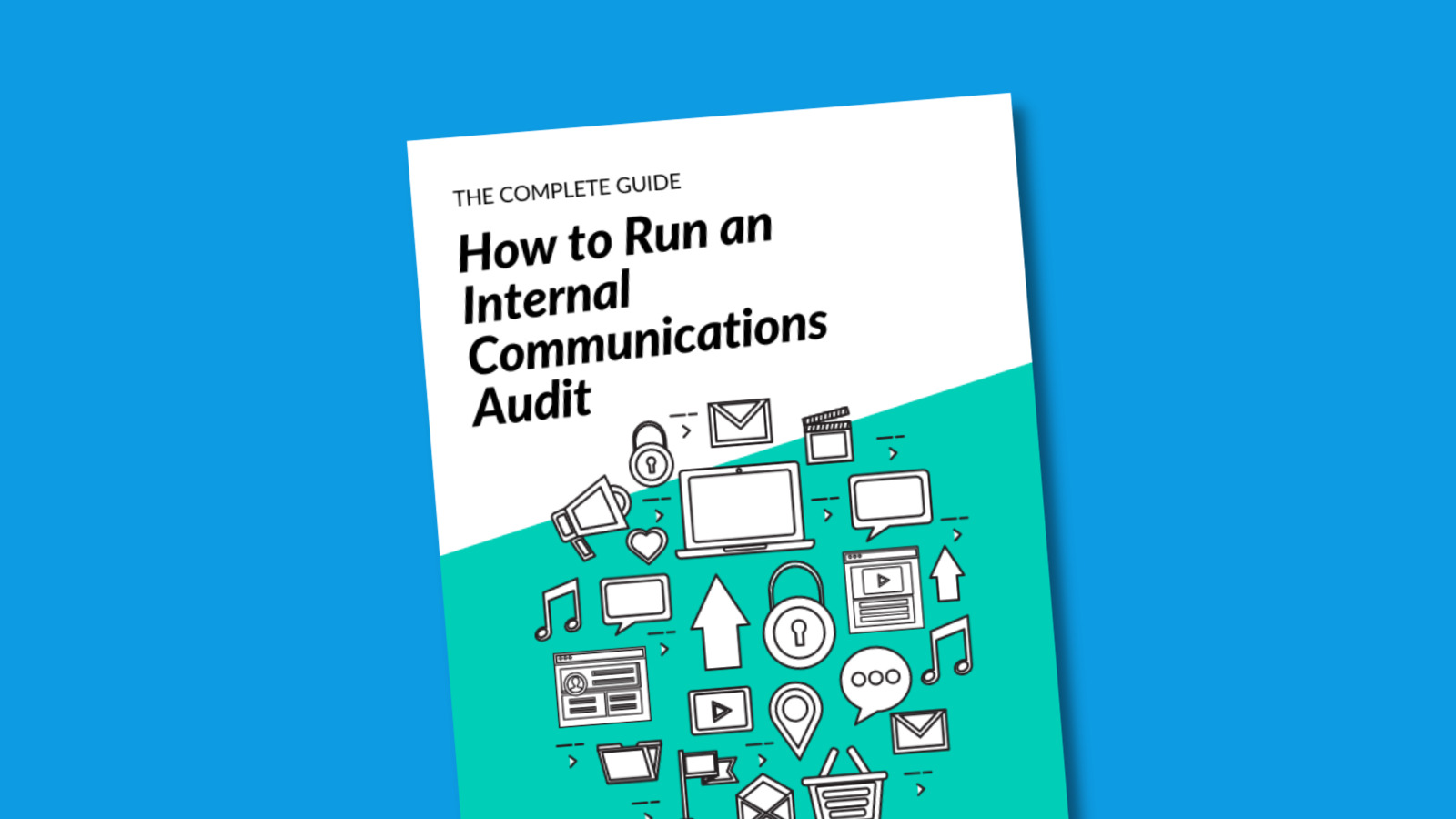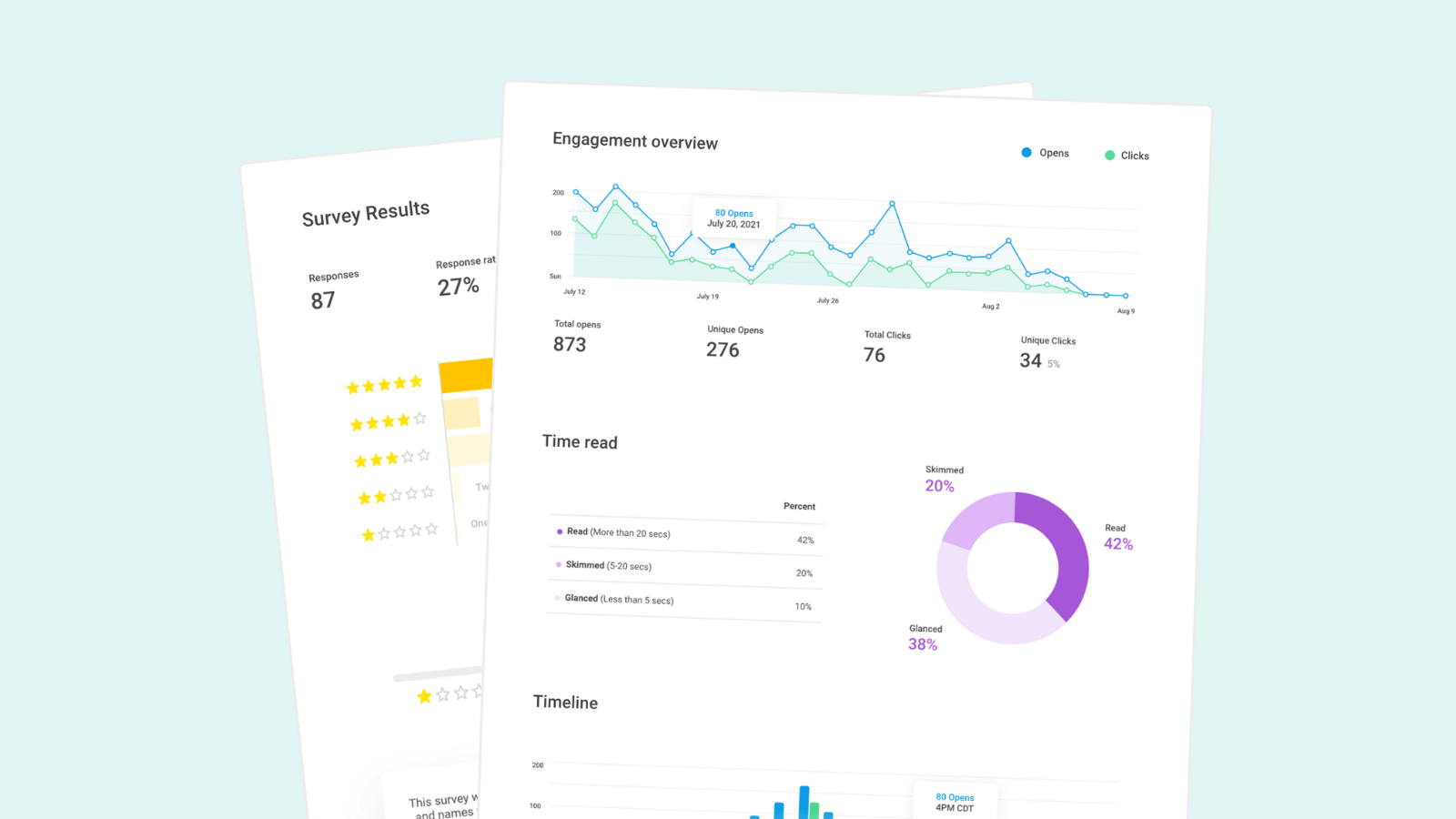How to run an impressive internal communications audit (in 7 steps!)

What is an internal communication audit?
An internal communication audit evaluates the effectiveness of your internal communication.
To us, internal communication goes far beyond just a company newsletter or a regular all-hands meeting, and includes how your managers, department heads, and other internal leaders are regularly communicating and getting in front of the company. It’s a matter of making sure that your company’s communication is transparent, efficient, inclusive, relevant, and creates a real sense of belonging in your organization. Done well, it can have incredible impact on your bottom line, increase your employee’s engagement and well-being, and create a true flywheel of success for your company. It can make your team look forward to Mondays and enjoy their work in an entirely new way.
To get a clear picture of the impact that communication has on your employees, we encourage every organization to start with an internal communications survey and/or audit. From there, you can determine whether it’s serving the needs of the company, or if it requires adjustment.
How can an internal communication audit help?
An audit is a key part of your strategic communication planning process. It can help you identify where you might be missing the mark with your internal comms, including gaps in information, messages that aren’t reaching your audience, miscommunications, and channels that aren’t delivering the way you wanted them to. It can help you establish a benchmark to measure performance, and give you a roadmap to start allocating your resources more effectively.
It’s also the best way to get buy-in on a senior leadership level. It provides data that will help you demonstrate that you understand how information flows throughout the company, and will give you what you need to inform the overall strategic direction of your internal communication going forward.
The 7 steps for an internal communications audit
Step 1: Identify the current state of internal comms
If you have an existing communications strategy, be sure your audit includes the qualitative and quantitative measures that will allow you to show whether it’s working (or not). Document as much as you can now, so it’s easy to tweak and identify issues later.
If you don’t have an existing internal comms strategy that you’ve created intentionally, that doesn’t mean your company is operating without internal communications. We guarantee that the channels and tactics that your leaders and employees use have formed without your intent and input in shaping them. If that’s the case, we recommend starting with an internal communications survey (we’ve created a template for that!) and figuring out where your company’s baseline is.
It may also be beneficial to put together a small focus group, or interview a cross-section of the company. Without structure in place, the odds are that a lot of your internal communications is currently happening in private channels, off the cuff, or potentially isn’t happening at all (you may find that one department or team is essentially ‘ghosting’ the company). That could be creating a lot of frustration at different levels, so you’ll want to really get into that and assess the issues before doing a full-scale audit.
Need a starting point?
We’ve created a complete guide to running an internal comms audit, including a set of 20+ question you can print off and/or document the answers to the following questions yourself, or with a small group of internal comms leaders within your company.

Download it here.
Step 2: Determine what you will evaluate
Make a list of the items, channels, and/or audiences you want to evaluate through the audit.
To get the most accurate picture of your employee communication, include content generated by all of the “corporate” business areas that exist to support employees internally, like human resources, IT, office staff, and maintenance.
Also determine whether you’re going to look at all formats, or focus on just one (printed materials, the company newsletter, meetings, etc.). For the purposes of this guide, we’re assuming you’re looking at everything.
Examples of what you could add:
- Channel effectiveness – Are employees opening those emails/seeing those messages? Do you have a way to measure that? What do your employees seem to prefer?
- Executive communication – Executives rarely have a shared definition or understanding of the purpose and value of internal communication, and they almost always think they’re better at it than they are. 🙂
- Cross-department communication – Once you have multiple employees within multiple departments, you’re going to start seeing silos form. Figure out where the biggest information gaps are (Product to Sales? Sales to Product? Marketing to the company?)
- Employee awareness – are your employees hearing you? Can they recite and retain the important information you want them to know?
- Approval process – Is senior leadership or parent company signoff required?
- Resources required – Are departments asking for internal marketing resources, like graphic design or copywriting?
Step 3: Get leadership buy-in
Your company’s C-suite and senior management need to be actively engaged in the creation of your internal communications strategy, and will play a key role in how it’s delivered to the company. It’s simply not enough to leave it up to the HR and Marketing teams to define and execute your plan.
That, of course, starts with the audit: you need leadership to be engaged in the process and need to know that they’ll have a desire to implement changes based on what you find. Remember: it’s one thing for your company to agree to doing an audit, but a whole other thing to know that they’re willing to do something about it!
A few ways you can make sure leadership is involved:
- Map your audit and follow-up strategy to their priorities! Don’t try to create entirely new initiatives. Instead, show how great internal communications can help the company promote, focus on, and deliver toward existing goals.
- Make it easy for them! Give leadership a roadmap of what they need to do to support the audit and your internal comms, and show how you’ll take full accountability for it.
Step 4: Choose your audience
Make sure you get a diverse set of opinions from across the company, including employees from all departments, functions, roles, locations, and levels. Seek permission from senior leadership (if you need it!) and get them bought into the importance of internal communications from the get-go.
Before you get into it, share with the company exactly why you are asking people to participate in the audit, and what you plan to do with their feedback.
Here’s an example:
“Hi Sarah!
⠀⠀⠀⠀⠀⠀⠀⠀⠀
We’ve selected a small group of employees at random to participate in an audit about the quality and effectiveness of our company’s internal communication strategy, channels, and messages. We’d love to hear your opinions on what’s working well, and where we can improve!
⠀⠀⠀⠀⠀⠀⠀⠀⠀
Your feedback will help us to deliver relevant, meaningful communication that supports the employee experience and the company’s goals. It will also help to clarify the key role that managers and leaders play in this communication, and identify what they need to do this well.
⠀⠀⠀⠀⠀⠀⠀⠀⠀
Our audit will kick off next Tuesday with a short 15-minute meeting. Let me know if you cannot attend or if you do not wish to participate!”
Step 5: Start your research!
Conducting an internal communications audit involves gathering up information from a few different places and bringing that together in a succinct, data-driven way.
As a note: The amount of time your audit will take to complete depends on how many channels you’re evaluating and how many people you get involved in it, but it can take anywhere from three weeks to three months.
If available, here are a few places to start, outside of your own analysis from a few steps ago:
1.) Employee engagement survey: Look at your company’s recent survey results and see if there are any pieces of it that call out internal communication successes or opportunities. You should be able to gather the team’s sentiments on how connected they feel to the work they’re doing, whether decision-making is transparent, whether they’d recommend the company to others, etc. If you need a few ideas to get started, we have create examples of employee survey questions here.
2.) An internal communications survey: This survey will help you get a sense of the culture that has already been built around internal communications, and see what is or isn’t working. We recommend sending out this survey every 6-12 months and all answers should be completely anonymous. If you haven’t done one recently, we’ve created a template here.
3.) Quantitative metrics: Pull any metrics you can from your existing communications channels. Open and click through rates from emails (track your results with a tool like Workshop), DMs sent in Slack, attendees on the all-company Zoom meeting, traffic to internal blog posts, etc.
4.) Qualitative interviews: Schedule a series of one-on-one interviews and small groups to dig into your survey data, uncover key issues, and gauge reactions. These should be conducted by a neutral party, so don’t interview any of your direct reports, and ensure the individuals involved that all of their answers will be anonymous.
5.) Specific examples: Gather a sample of digital and printed content from the past six to 12 months and assess it yourself, or have individuals or focus groups assess it.
For focus groups, keep them small (8-10 people max) and be sure that their managers aren’t present in the same group, as well. If you save the one-on-one interviews for last, you may be able to really identify employees that will provide the perspective you need to round out your data set, and get to the bottom of any key problem (or come up with some really amazing solutions).
Step 6: Review the data and put together your recommendations and action plan
Pull together everything you’ve documented so far. Be as objective as possible, and be honest and transparent about the company’s successes and opportunities.
Your initial internal comms analysis from Step 1 will help frame specifically what the issues are from a communicator’s perspective, but don’t let that influence the data from the wider company; after all, it’s their feedback that matters the most. Review all the information you have and put together a formal recommendation.
When putting together your action plan, start with low-hanging fruit. Focus on small improvements that can be made quickly and generate meaningful results. This will help build positive momentum for your solution and get instant buy-in.
From there, plan for changes that will have the biggest impact on areas of concern for the company: cost, employee engagement, efficiency, company culture, productivity, etc.
We recommend building the plan in segments of 3, 6, 12, and 18 months. Incorporate a formal plan and outcome review every quarter, and plan on doing the next audit in 18 months!
Step 7: Publish the report and share your insights
Whatever you do, don’t forget to communicate what you have learned through your audit. This is important for all your audiences and stakeholders, and especially for those who participated in the research. People support what they help to create so make sure you tell people what you discovered, how you plan to address it and by when.
We recommend the following structure, in this order:
- Start with the executive summary, and include your final conclusion. They shouldn’t have to read the entire report to get to the big takeaways…just lead with it!
- Describe the problem you’re solving, and why they should care. Everyone reading it should be on the same page about why internal communication is critical to the company’s success.
- Describe the current state, and what the company is doing about it. Make sure you show that you understand the company’s current approach, and if you agree or disagree with it. Put together an overall analysis of employee opinions and perceptions from the survey you ran.
- What’s the benefit of getting this right? Show competitors or leaders that are solving internal communications really well. Highlight industry statistics that speak to the problems you know these stakeholders are dealing with.
- What is your proposed solution? Jump into your recommendations for improvement, whether it’s purchasing new software, improving processes, or providing skills training.
- What’s the cost of the solution? Solutions cost time, money, and resources. What are you asking for? You want to be clear and articulate about the complete cost of your solution. Remember: this is not just about money…it’s about the overall cost of time to implement the solution, changing habits, full-time hires, etc.
- What’s the cost of doing nothing? There is a cost of not investing in a solution, and when it comes to internal communications, it can be pretty severe. Show how the cost of taking control of the company’s internal comms and creating thoughtful, intentional messaging is so much better than letting everything just ‘happen’.
- How will you execute it? You don’t need a four-page rollout plan, just a paragraph or two, but this is a good way to demonstrate that you’ve thought it through and that you have a strong plan of action. It shows accountability and responsibility in a great way. 🙂
- What are the action items? Be clear about exactly what you need from the person reading the report. If the report is going to executives, ask them for their sign-off on a budget/the action plan; if it is being sent to the greater company, ask them to play an active role in the company’s internal communications. (You may need to adapt this section depending on who you’re speaking to.)
Done properly, this internal communications audit is perfect for generating insights that can help your company achieve its goals, strengthen your team’s bond, and help leaders within your organization to shine just a bit brighter.
Every company that completes this audit will wind up somewhere on a spectrum, from finding that their workforce feels very disconnected, to discovering that their employees are completely overwhelmed by communications. Regardless of where you fall, Workshop can help. We’ll work with you to create a streamlined internal communications strategy, including all-company newsletters, policy updates, office closures, new hires, letters from the CEO, and more (all within a single piece of software).
Related resources:
Download the Internal Comms Survey template: The first step of auditing and assessing your internal communications is to survey your employees and find out what is and isn’t working with your existing channels. It is a great place to start whether you’ve had a formal strategy in place all along or are putting together an internal comms plan for the first time.
Learn more about Workshop and how we can help you create a streamlined internal communications strategy! Request a demo here!








